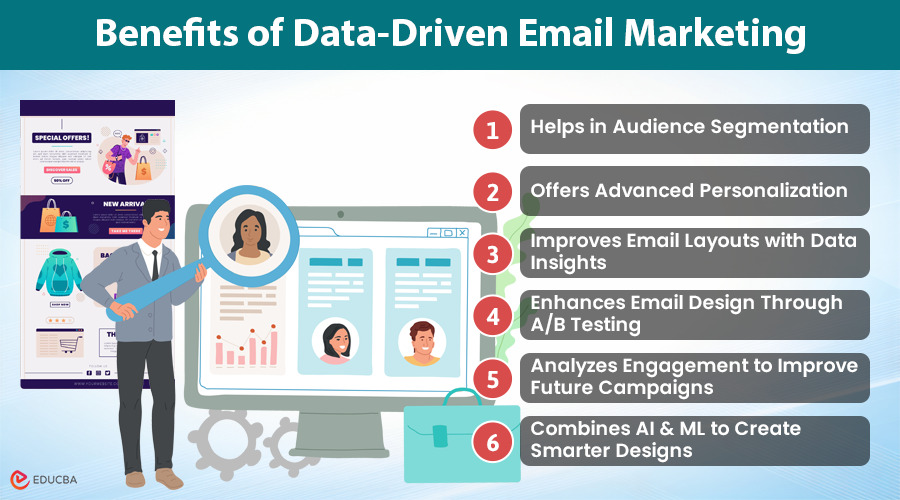
What is Data-Driven Email Marketing?
In data-driven email marketing, businesses use customer data, like demographics or shopping habits, to create and send personalized email designs to different customers.
Instead of sending the same email to everyone, businesses can tailor the content based on what they know about customers.
For instance, some subscribers may prefer minimalistic designs, while others might engage more with interactive elements like gifs or videos. By leveraging this data, businesses can optimize their email designs to resonate more with their target audience, enhancing the likelihood of engagement.
Benefits of Data-Driven Email Marketing
1. Helps in Audience Segmentation
Audience segmentation is a core benefit of data-driven email marketing. It helps you divide your email list into different groups based on factors such as:
- Demographics: Age, gender, location.
- Purchase History: What they’ve bought before.
- Engagement: How often they open or interact with your emails.
- Interests: The type of content they prefer.
For example, younger audiences may prefer bold, trendy designs, while older audiences may favor clear and simple layouts. By customizing email design for each segment, your campaigns become more relevant, leading to higher open and conversion rates.
2. Offers Advanced Personalization
In basic marketing emails, we generally see the recipient’s first name in the email. However, data-driven email marketing goes beyond this. When marketers have relevant data, they personalize emails using the recipient’s preferences, purchase behavior, or browsing history. This level of customization goes beyond aesthetics; it addresses the individual needs of each user, making them feel valued.
For example, a clothing retailer can send personalized emails based on the customer’s past purchases. If a user frequently buys winter wear, the design of their email could feature winter collections, colors, and images, while another user who prefers summer wear receives a completely different design.
Also, elements like images, call-to-action buttons, or special offers can change based on the user’s location, preferences, or browsing history. This heightened level of personalization creates a more engaging experience for the customer.
3. Improves Email Layouts with Data Insights
In data-driven marketing, marketers can analyze metrics like click-through rates and heatmaps and identify which parts of an email capture the most attention and which sections get overlooked. They can use this information to structure future emails for optimal performance.
For example, if heatmap analysis shows that users are clicking more on images than text, marketers can create designs that feature larger visuals while keeping text concise. Additionally, data may indicate that placing call-to-action buttons in the top half of emails boosts click rates, prompting adjustments in layout.
4. Enhances Email Design Through A/B Testing
No email design strategy is complete without continuous testing. A/B testing, which involves sending two variations of an email to different segments of your audience, can help pinpoint which designs, headlines, and calls-to-action resonate best with users. By testing variables such as subject lines, button colors, and image placement, marketers can refine their email designs to maximize impact.
For example, testing different CTA button colors (say, red versus blue) can reveal which one drives more conversions. Similarly, experimenting with image-heavy designs versus minimalistic layouts can help determine which is more effective for different audience segments.
5. Analyzes Engagement to Improve Future Campaigns
For example, if a particular design achieves a significantly higher open rate, examining its specific elements (like colors and layout) can provide insights for replicating that success. Conversely, understanding underperforming emails can help marketers avoid similar mistakes in the future.
6. Combines AI and ML to Create Smarter Designs
Artificial Intelligence (AI) increasingly enhances data-driven email marketing. As it analyzes vast amounts of customer data, it can easily recommend optimal email designs and layouts. Similarly, Machine Learning (ML) algorithms can suggest changes to campaigns, like adjusting subject lines or proposing personalized content.
Moreover, AI-powered tools can predict which types of designs will resonate most with different audience segments. These insights can lead to highly customized email campaigns that feel more tailored and authentic to recipients.
Final Thoughts
The future of email marketing is about using data and design to create effective campaigns. Businesses should blend data, creativity, and testing to create better email campaigns. This helps emails look good and get people to engage and buy the product or service.
Recommended Articles
If you found this article on “Data-Driven Email Marketing” helpful, consider reading the following recommendations.

